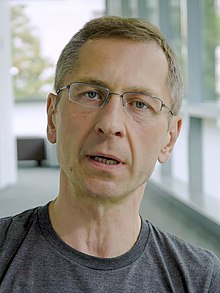Fyodor Urnov
Fyodor Urnov | |
|---|---|
 | |
| Born | Фёдор Урнов 1968 (age 55–56) |
| Alma mater | |
| Known for | Genome editing |
| Scientific career | |
| Institutions | |
| Academic advisors | Susan Gerbi |
Fyodor Dmitriyevich Urnov (Russian: Фёдор Дми́триевич Урнов; born 1968)[1][2] is Russian-born biomedical researcher and who has played a leading role in the field of genome editing. He is a Professor of Genetics, Genomics, and Development at the University of California, Berkeley and Director of the Center for Translational Genomics at the university's Innovative Genomics Institute.[3][4][5] In 2005 Urnov and his colleagues coined the term "genome editing" and demonstrated the first use of ZFNs to edit DNA in human cells.[6][7][8] Urnov is considered a pioneering figure in the field of genome editing[7] and his work has been cited widely.[9][10][11]
Early life and education[edit]
Fyodor Urnov was born in Soviet Russia to a linguist mother and a literary critic father. He was raised in Moscow. Urnov's father frequently purchased him books; on his 12th birthday, Urnov received a copy of James D. Watson's book The Double Helix. The book helped to spark Urnov's early interest in life sciences.[12]
Urnov attended Moscow State University, where he received his undergraduate degree in biology in 1990. Following the fall of the Iron Curtain, Urnov applied to graduate schools in the United States. He attended Brown University for doctoral studies where he worked as a researcher in the laboratory of Susan Gerbi.[12] He received his Ph.D. from Brown in 1996.
Career[edit]
After graduating, Urnov worked with DNA in the laboratory of Alan Wolffe at the National Institutes of Health. In 2000, Urnov followed Wolffe to Sangamo Therapeutics where he had been recruited as Chief Scientific Officer. Shortly after moving to the San Francisco Bay Area, Urnov was offered an adjunct position as a lecturer at the University of California, Berkeley.[12]
In 2005 Urnov's team at Sangamo demonstrated the first use of ZFNs to edit DNA in human cells and coined the term "genome editing."[8]
In 2019 Urnov joined UC Berkeley as Professor of Genetics, Genomics, and Development and Director of the Center for Translational Genomics at the Innovative Genomics Institute.[3][4][13]

References[edit]
- ^ Urnov, Fyodor Dmitriyevich (1996). The origin of DNA amplification in Sciara coprophila DNA puff II/9A: nucleotide sequence, chromatin structure, and protein-DNA interactions (Thesis). OCLC 83539763.
- ^ Урнов, Дмитрий (2021-06-12). Литература как жизнь. Том I (in Russian). Litres. ISBN 978-5-04-349013-1.
- ^ a b "Fyodor Urnov". Innovative Genomics Institute (IGI). Retrieved 2022-04-05.
- ^ a b "Fyodor Urnov Appointed IGI Scientific Director of Technology and Translation". Innovative Genomics Institute (IGI). Retrieved 2022-02-05.
- ^ "Fyodor Urnov | Research UC Berkeley". vcresearch.berkeley.edu. Retrieved 2022-02-05.
- ^ Morange, Michel (2020-06-09). The Black Box of Biology: A History of the Molecular Revolution. Harvard University Press. p. 307. ISBN 978-0-674-24525-9.
- ^ a b Friedrichs, Steffi; Takasu, Yoko; Kearns, Peter; Dagallier, Bertrand; Oshima, Ryudai; Schofield, Janet; Moreddu, Catherine (2019-08-01). "Meeting report of the OECD conference on "Genome Editing: Applications in Agriculture—Implications for Health, Environment and Regulation"". Transgenic Research. 28 (3): 419–463. doi:10.1007/s11248-019-00154-1. ISSN 1573-9368. PMC 6647521. PMID 31309374.
- ^ a b Corbyn, Zoë (December 2015). "Research: Biology's big hit". Nature. 528 (7580): S4–S5. Bibcode:2015Natur.528S...4C. doi:10.1038/528S4a. ISSN 1476-4687. PMID 26630597. S2CID 88658792.
- ^ David, Cyranoski. "DNA Editing of Human Embryos Alarms Scientists". Scientific American. Retrieved 2022-02-06.
- ^ Sheridan, Cormac (2021-12-15). "Off-the-shelf, gene-edited CAR-T cells forge ahead, despite safety scare". Nature Biotechnology. 40 (1): 5–8. doi:10.1038/d41587-021-00027-1. PMID 34912036. S2CID 245219506.
- ^ "World's Most Influential Scientific Minds: 2014" (PDF). Thomson Reuters. p. 16.
- ^ a b c "Devoted to DNA". www.asbmb.org. Retrieved 2022-02-05.
- ^ "Fall 2019 New Faculty Profiles". Molecular and Cell Biology. 2019-11-05. Retrieved 2022-02-05.
External links[edit]
- Fyodor Urnov publications indexed by Google Scholar
